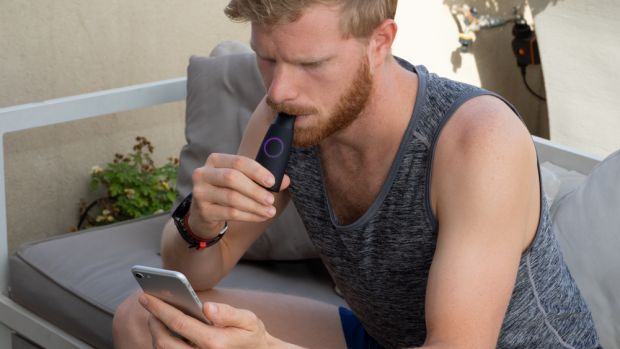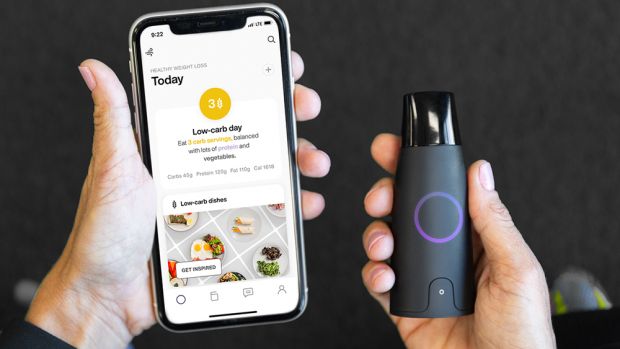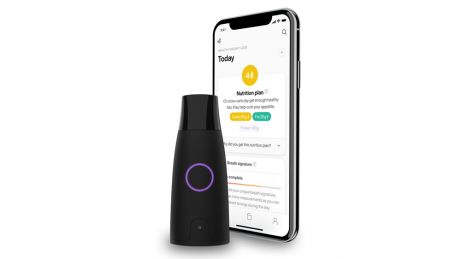You can trust Coach
Lumen is both a very complicated and a very simple device. It has a single purpose – to tell you if your body is using carbs or fat as fuel, which it does by analysing your breath. After that reading it gets a whole lot more complex, because Lumen’s aim is to improve your metabolic flexibility.
So what is that? Essentially, it’s how well your body is able to shift between the different fuel sources. A higher level of metabolic flexibility promises higher energy levels and more stable energy levels too so you’re not crashing every afternoon. Your body will be able to burn fat and build lean muscle more effectively, helping with weight management. In general your body will be running more smoothly and you’ll be in a better mood, which all sounds lovely.
To help you achieve this ideal state, Lumen generates a weekly score to show how metabolically flexible you are, based on you breathing into the device each morning and then at intervals throughout the day – usually after a workout or a meal – to check whether you’re in fat or carb burn. After each breath you get a rating out of five: one and two indicate fat burn, and three, four and five various states of carb burn.

In the morning the expectation is that you wake up using fats for fuel, which shows your body has worked through the carbs you’ve eaten the previous day. After a high-carb meal you want your body to move into carb burn so it’s using them up, rather than storing them as excess fat.
The testing process is a bit of a faff. You have to be relaxed, with a resting heart rate, because your body burns more carbs when your heart rate is elevated, which can skew the readings. Once you’re ready, you take a big breath in, hold it for 10 seconds, and then exhale slowly. The Lumen app guides you through the process, using a circle that expands as you inhale, and then uses a ball on a line to help you exhale at the correct rate.
Fitting the test in at Lumen’s recommended times was not always easy in practice. The morning breath has to be done a little after you’ve woken up, but before you eat or drink anything other than water or black coffee. Finding a couple of minutes each morning when trying to also dress and feed a one-year-old before taking them to nursery turned out to be pretty inconvenient.
It’s also possible to mess up the breathing part of the test and have to repeat it, and initially Lumen requires two breaths for each test. The process could easily stretch to five minutes or more, which isn’t very long, but feels it in the middle of a busy morning.
After a week of taking the tests the device generates a Lumen Flex Score, which is updated weekly. (Lumen is planning to bring in a daily score, which will help make the experience more engaging.) The Lumen Flex Score is out of 21, and the higher the score the better – 0-6 represents low flexibility, 7-14 medium flexibility and 15-21 high flexibility.
Lumen is not simply a passive experience though – it will actively help you to achieve better flexibility. Each day there’s a suggested breakdown of the number of 15g portions of carbs you should have, and the app has portion size examples to help you eat the right amount too.
It’s also possible to mess up the breathing part of the test and have to repeat it, and initially Lumen requires two breaths for each test. The process could easily stretch to five minutes or more, which isn’t very long, but feels it in the middle of a busy morning.
After a week of taking the tests the device generates a Lumen Flex Score, which is updated weekly. (Lumen is planning to bring in a daily score, which will help make the experience more engaging.) The Lumen Flex Score is out of 21, and the higher the score the better – 0-6 represents low flexibility, 7-14 medium flexibility and 15-21 high flexibility.
Lumen is not simply a passive experience though – it will actively help you to achieve better flexibility. Each day there’s a suggested breakdown of the number of 15g portions of carbs you should have, and the app has portion size examples to help you eat the right amount too.

As someone who always woke up in fat burn, but struggled to shift into carb burn, I would sometimes be recommended high-carb days where the Lumen asked me to take a reading after a high-carb meal to see if I then moved into carb burn.
I’m a very keen runner and eat a substantial amount of carbs to fuel my training – a frankly grotesque amount at times, such as while carb-loading before a marathon, which was when I was using the Lumen. However, even after the carbiest of meals I would find that at most I’d hit level 2, which is still fat burn. Every morning I woke up in fat burn too, despite being a late-night snacker.
Despite this failing to enter carb burn at any point, I have been rated at 16-17 on my score for the past two weeks.
I asked Lumen why this might be the case and the suggested explanation is that I use all my carbs up with my training and so I am replenishing my glycogen reserve’s with each meal, so my body doesn’t burn the carbs but stores them.
If that is the case, I’m a little baffled as to what Lumen offers me. I eat loads of carbs and don’t seem to shift into carb burn, but still get a high Lumen Flex Score because, presumably, I wake up in fat burn. On those days Lumen asks me to eat more carbs in the expectation of a carb burn reading after a meal, which I don’t manage, the next day the recommendation will return to medium- or low-carb intake.
See related
- The Best Fitness Trackers Of 2021
- Oura Ring Review: The Best Sleep Tracker
- What You Need To Know About Your Metabolism For Weight Loss
Perhaps there’s a more practical use if you are trying to manage your weight. If you consistently wake up to find your body is using carbs as fuel, extending your overnight fasting window and following Lumen’s recommendations when it comes to your daily macros may well improve your metabolic flexibility.
The app does a great job of explaining all of this as well, and you can dive deep into its various recommendations. If you have a Garmin watch you can also link this with Lumen to send details to the app like your heart rate throughout the day, sleep and general activity.
However, you will need to log what you eat yourself. If you are aiming to use Lumen to manage your weight and increase your Lumen Flex Score, it is important to at least log your carb servings before your first breath test the following day.
This adds another level of inconvenience to using the device, though, and after almost six weeks with the Lumen I’d describe it as a bit of a pain. While that may partly be down to my experience of receiving the same readings every time, I think most people will find it tiresome to take the tests several times a day – or even just once in the morning.
It’s certainly hard to say that the device justifies its £349 price, or even the £299 it’s been reduced to during the time I’ve used it. It’s a niche product and even if you are fully invested in becoming more metabolically flexible, I’m not sure you’re getting any profound insights here – fast longer overnight, eat fewer carbs.
Having a device to help you do these things and check you’re getting the results you want is great, and the Lumen app is very well put together. However, you are going to have to work fairly hard yourself to log your macros and take frequent breath tests. My gut feeling is that anyone prepared to pay for a Lumen and put in that work will probably have a reasonable idea of what they should be doing with their diet. I could be completely wrong of course, and understanding theory doesn’t mean you’ll execute it in practice as well as you would with a device to guide you.
The Lumen provides a glimpse of an area the fitness tracking industry might well move into. The idea of improving your metabolic flexibility is an attractive one and a great health goal to have alongside something exercise-based like taking 10,000 steps a day or logging 150 active minutes a week. If the technology gets cheaper and easier to sync with other devices then we might all be checking our breath each morning soon but while it’s a standalone device, I’m not sure there’s enough value here for people to spend £300.
Buy from Lumen | £349 (currently reduced to £299)

Nick Harris-Fry is a journalist who has been covering health and fitness since 2015. Nick is an avid runner, covering 70-110km a week, which gives him ample opportunity to test a wide range of running shoes and running gear. He is also the chief tester for fitness trackers and running watches, treadmills and exercise bikes, and workout headphones.

